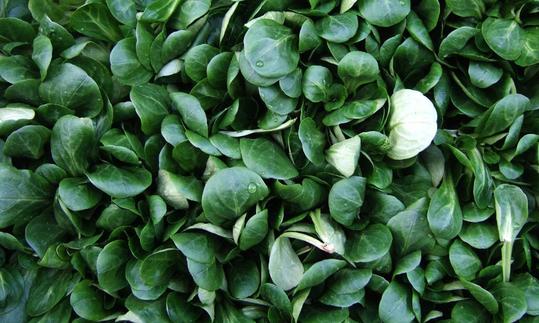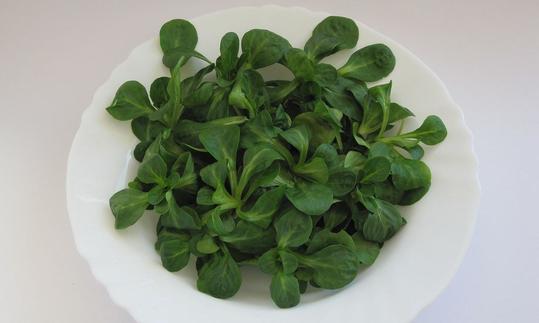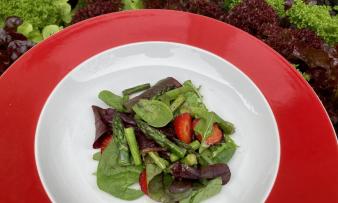Table of contents
Lamb 's lettuce ( Valerianella locusta) is a typical autumn and winter salad with a nutty taste and lots of vitamins.
Use in the kitchen
Lamb's lettuce tastes spicy and has a light, mild nutty note. Some varieties taste like hazelnuts. It has dark green, tender leaves of different sizes, which together form a small basal rosette with up to 20 leaves.
Before preparing lamb's lettuce, you should always wash it well, but not under running water, as the leaves are very delicate. It is best to put it in a bowl of water and gently move it back and forth in the water bath. If it is very dirty, you may have to change the water several times.
Can you eat lamb's lettuce raw? Lamb's lettuce is usually eaten raw because of its tender leaves. As a typical autumn and winter salad, it combines well with fruit such as apple, pear, plum, figs or orange. Lightly fried porcini mushrooms, button mushrooms as well as pumpkin or sweet potatoes also taste great as a side dish to lamb's lettuce. A topping of walnuts or pumpkin seeds gives the salad a crunchy, nutty addition. You can make an oil-free salad dressing with walnuts either as a raw vinaigrette with balsamic vinegar or as a dressing with orange juice and ginger. Optionally, you can also make an oil-free dressing from avocado and lemon.
Lamb's lettuce tastes delicious in soups and stews. It is important to ensure that it is cooked for a short time and that the lettuce is only added at the end of the cooking process. Lamb's lettuce is also a good alternative to spinach for raw vegan smoothies, e.g. with apple and bananas or beetroot and orange.
Vegan recipe with lamb's lettuce and pumpkin
Ingredients (for 2 people): 500 g Hokkaido pumpkin or butternut squash, 2 beetroots, 1 sprig of rosemary, salt,black pepper, 150 g lamb's lettuce, 150 g rocket, 2 handfuls of walnuts, 2 tbsp cranberries, 1 tbsp nut butter (macadamia butter, cashew butter, almond butter), juice of 1 lime, 5 tbsp drinking water, 1 clove of garlic.
Preparation: Cut the pumpkin and beetroot into bite-sized pieces, season with rosemary, salt and pepper to taste and bake in the oven at 200 °C for around 30 minutes. Chop the walnuts. Wash the lamb's lettuce with rocket and divide between two plates. For the dressing, mix the nut butter, lime juice and water well in a bowl. Squeeze a clove of garlic and add to the dressing, season with salt and pepper if necessary. Place the still warm oven-baked vegetables on the salad, decorate with walnuts and cranberries and spread the dressing over the top.
Vegan recipes with lamb's lettuce (raw) can be found under the note: " Recipes that have the most of this ingredient ".
| Not only vegans or vegetarians should read this: Vegans often eat unhealthily. Avoidable nutritional errors. |
Purchasing - Storage
Supermarkets such as Coop, Migros, Denner, Volg, Spar, Aldi, Lidl, Billa, Rewe, Edeka or Hofer offer lamb's lettuce mainly in spring, autumn and winter. Organic quality is definitely available in organic supermarkets such as Denn's Biomarkt or Alnatura. Regional products can be found in season at the weekly market, directly from the farm or in subscription boxes.
Depending on when it is sown, lamb's lettuce can be harvested from October to March. However, thanks to greenhouse cultivation, it is now available in stores almost all year round. 8
The availability of lamb's lettuce in the supermarkets mentioned varies depending on the size of the store, catchment area, etc. If you are interested, click on our recorded food prices for the DA-CH countries (above under the ingredient image). There you will find current prices from various supermarkets and their price development.
Storage tips
Lamb's lettuce is not suitable for storage, it should be eaten as fresh as possible. It will last for around 3 to 4 days in the fridge. 2
Found in the wild
In Europe, lamb's lettuce occasionally grows wild on field edges, roadsides and roadsides. It can also be found on railway embankments and rubble sites, as well as on fallow fields, vineyards and grassy areas. 8 There is a risk of confusion with young forget-me-nots ( Myosotis), which, however, have short, bristly hairs on their leaves. 9
Ingredients - Nutritional values - Calories
Lamb's lettuce (raw) contains about 93% water and is low in calories at 21 kcal/100g. The protein content (2 g/100g) is low and there is hardly any fat (0.40 g/100g). Lamb's lettuce contains about 3.6 g/100g carbohydrates. 3
Lamb's lettuce is a good source of bioactive compounds such as phenols, carotenoids and chlorophyll, which have antioxidant effects. 1
Does lamb's lettuce contain fiber? Lamb's lettuce contains little fiber, at 1.7 g/100g. 4 Endive and chicory have significantly more fiber, both containing 3.1 g of fiber per 100 g. 3
Lamb's lettuce stands out from other leaf lettuces mainly because of its high vitamin C and vitamin A content. Raw lamb's lettuce contains plenty of vitamin C at 38 mg/100g (48% of the daily requirement). This is almost the same amount as lemon juice (39 mg/100g). Raw kale contains even more vitamin C at 120 mg/100g, which corresponds to 150% of the daily requirement. 100 g of raw yellow bell peppers contain so much vitamin C that 229% of the daily requirement is covered (184 mg/100g). 3
Vitamin A is also present in abundance, as RAE. 100 g of lamb's lettuce cover 44% of the daily requirement (355 µg/100g). Garden cress with 346 µg/100g and romaine lettuce with 436 µg/100g have similar values. Carrots are known for their high vitamin A content, with 835 µg/100g covering around 104% of the daily requirement. 3
Potassium is contained at 459 mg/100g. This corresponds to around 23% of the daily requirement. Raw kale (491 mg/100g) and raw spinach (558 mg/100g) have a similar content. This is high compared to other leaf salads, e.g.lettuce has 238 mg per 100g, romaine lettuce 247 mg and rocket 369 mg. Good sources of potassium are pulses and nuts, such as almonds (733 mg/100g) or chickpeas (718 mg/100g). 3
Does lamb's lettuce contain vitamin K? Some websites list vitamin K as a component of lamb's lettuce, but credible sources are usually lacking. Neither the American ( USDA), the Austrian ( ÖNWT), the German ( DEBInet) nor the Swiss nutritional database list vitamin K for lamb's lettuce. Furthermore, we cannot find any publications that discuss a relevant connection between vitamin K and lamb's lettuce.Lettuce, romaine lettuce, rocket and watercress contain measurable amounts of this fat-soluble vitamin.
You can find all the ingredients of lamb's lettuce, how much it covers your daily needs and comparison values with other ingredients in our nutrient tables below the ingredient image.
Effects on health
Is lamb's lettuce healthy? Lamb's lettuce is healthy because it contains numerous nutrients. 100 g of raw lamb's lettuce provides almost half of an adult's daily vitamin C and vitamin A requirements. 3 Vitamin C is a water-soluble vitamin and antioxidant that performs various tasks in the body. Among other things, it inhibits the formation of carcinogenic nitrosamines from nitrite and amines in the stomach and promotes the absorption of iron. 12 Vitamin A is fat-soluble and occurs in various forms, including beta-carotene. It is essential for good vision; a deficiency leads to corneal clouding and blindness. It is also involved in the formation of skin, mucous membranes and bones. 12
Dangers - Intolerances - Side effects
Like other leafy and root vegetables, lamb's lettuce contains nitrate, which it needs as a source of nitrogen for growth. Some plants accumulate more nitrate than others (spinach, rocket, lettuce, beetroot, radish). Since lamb's lettuce is mainly grown in winter, it contains relatively high levels of nitrate. The values also differ between outdoor cultivation (approx. 2000 mg/kg) and greenhouse cultivation (approx. 2580 mg/kg). There are no maximum nitrate values for lamb's lettuce, as there are for other lettuces. 11 Nitrate is converted to nitrite in food or in the body, which can be a problem for some groups of people (e.g. babies and small children). 10 For more on the nitrate and nitrite problem, see Batavia lettuce.
Nitrite can form compounds with amino acids (amines and amides) and form nitrosamines. This is less of a problem in low-protein vegetables than in protein-rich cured meat, where nitrosamines can form when heated (fried or grilled). 10 Protective ingredients, such as ascorbic acid (vitamin C), can prevent the formation of nitrosamines in foods (e.g. vegetables). 15
Lamb's lettuce contains oxalic acid, which is said to inhibit the absorption of certain minerals ( calcium, magnesium, iron). Since the resulting oxalic crystals can contribute to the formation of kidney stones or lead to a mineral deficiency, sensitive people (children or people with gallbladder or kidney diseases) should avoid too much oxalic acid. However, the occasional consumption of plants with a high oxalic acid content does not pose a problem for healthy people. 13 Steaming or boiling (and then throwing away the cooking water) reduces the oxalic acid content. However, this also means that valuable water-soluble vitamins are lost. 14
Ecological footprint - animal welfare
The CO 2 footprint of regional lamb's lettuce is 0.3 kg CO 2 eq/kg. This is similar to the footprint of fresh kale (0.3 kg CO 2 eq/kg) or spinach (0.2 kg CO 2 eq/kg). 18 In Germany, lamb's lettuce is mainly grown outdoors, which means that there are no emissions from heated greenhouses. 19
There are no exact figures on the amount of water required to produce 1 kg of lamb's lettuce.
In Germany, there are no specific herbicides approved for lamb's lettuce. In conventional agriculture, emergency approvals for broad-spectrum herbicides are therefore used and work is underway to obtain approval for specifically effective herbicides. 19 Mechanical and manual weed removal is significantly more complex, but definitely more environmentally friendly.
When buying lamb's lettuce, give preference to organically grown ones, as tests on conventional lamb's lettuce showed pesticide residues above the maximum limit. 17
Worldwide occurrence - cultivation
Originally, common lamb's lettuce grew in its wild form in the Mediterranean region and from North Africa to India. 6 Lamb's lettuce has been cultivated since the 16th century, and has spread enormously due to human influence. 7 Today it also grows in parts of North America and in the temperate zones of East Asia. Lamb's lettuce was very popular as a winter and spring salad before winter lettuce began to be cultivated. 6
Lamb's lettuce and other leaf lettuces are grown worldwide, with China, the USA and India being the main growing areas in 2020. In Europe, lettuce is mainly produced in Spain, Italy, Belgium and France. 16
Cultivation - Harvest
Lamb's lettuce can be easily planted in a garden bed or in a pot. A sunny location and humus-rich soil are important. Depending on the variety, direct sowing outdoors takes place either in summer (July to September), in autumn (from October) or in late winter (February to mid-March). When sowing in winter, a fleece cover is required. When sowing directly in the bed, furrows are made with a depth of 0.5 to 1 cm and a distance of 10 cm. The seeds are sown in the furrows at a distance of approx. 3 cm. Carefully cover with a little soil and then water well. Lamb's lettuce needs consistent moisture to germinate. The lettuce germinates after 2 to 3 weeks. Regular watering and removing weeds as well as loosening the soil are important for the lettuce to grow well. Fertilizing lamb's lettuce is not necessary. 5
If you sow lamb's lettuce in the summer, you can harvest it after 8 to 10 weeks. If you sow later, you can harvest it after 16 weeks at the latest. Lamb's lettuce is usually harvested as a whole floret by cutting the leaves just above the root. Lamb's lettuce should always be washed shortly before use. 2
Further information
Common lamb's lettuce ( Valerianella locusta) belongs to the honeysuckle family (Caprifoliaceae) and the subfamily of the valerian family (Valerianoideae). It is a mostly annual, hardy plant with a height of 5 to 15 cm. Its simple leaves are 5 to 30 mm long and are arranged in a basal rosette.
Alternative names
include lamb's lettuce, field lettuce, mouse ear lettuce, sheep's mouth, little nuts, nutlets, sun swirls and rapunzel. In Austria it is called Vogerlsalat and in Switzerland it is called Nüsslisalat.
In English, lamb's lettuce is called lamb's lettuce, nut lettuce, common cornsalad, field salad, mâche (mache), fetticus or valerian salad.
Bibliography - 19 Sources (Link to the evidence)
| 1. | Hernández V, Botella MÁ, Hellín P, Cava J, Fenoll J, Mestre T, Martínez V, Flores P. Phenolic and Carotenoid Profile of Lamb's Lettuce and Improvement of the Bioactive Content by Preharvest Conditions. Foods. Jan 2021 18;10(1): 188. |
| 2. | Planatura.garden. Feldsalat ernten, lagern & zubereiten. |
| 3. | USDA United States Department of Agriculture. |
| 4. | Schweizer Nährwertdatenbank. |
| 5. | Planatura.garden. Feldsalat anbauen: Aussaat, Standort & Pflege. |
| 6. | Prance SG, Nesbitt M. The Cultural History of Plants. New York: Routledge; 2012. 121. |
| 7. | Davidson A. The Oxford Companion to Food. Oxford: OUP Oxford; 2014. 222. |
| 8. | Forwick J, Wunder J, Wingender R, Möseler BM, Schnabel H. Morphometrische und molekularbiologische Erfassung und Untersuchung von Wildpflanzenpopulationen in Nordrhein-Westfalen als pflanzengenetische Ressourcen. Landwirtschaftliche Fakultät der Universität Bonn. Schriftenreihe des Lehr- und Forschungsschwerpunktes USL, 114, 2003: 7-8, 106. |
| 9. | Die Umweltberatung Wien. Lebensmittellexikon Vogerlsalat. |
| 10. | BfR Bundesamt für Risikobewertung. Fragen und Antworten zu Nitrat und Nitrit in Lebensmittel. 2013. |
| 11. | Bayerisches Landesamt für Gesundheit und Lebensmittelsicherheit. Nitrat in Feldsalat - Untersuchungsergebnisse 2014. |
| 12. | Biesalski H K, Grimm P. Taschenatlas der Ernährung. Stuttgart: Georg Thieme Verlag; 2015, 6. Auflage. 144-153, 172-175, 294. |
| 13. | Weiss C. Oxalsäure. Ernaehrungs-umschau. PDF. 11/2009. |
| 14. | Chai W, Liebman M. Effect of different cooking methods on vegetable oxalate content. Journal of Agricultural and Food Chemistry. 20. April 2005;53(8): 3027–30. |
| 15. | Tannenbaum SR, Wishnok JS, Leaf CD. Inhibition of nitrosamine formation by ascorbic acid. The American Journal of Clinical Nutrition. Jan 1991;53: 247-250. |
| 16. | FAOSTAT Food and Agriculture Organization of the United Nations. Lettuce and chicory (2020). |
| 17. | Niedersächsisches Landesamt für Verbraucherschutz und Lebensmittelsicherheit. Pflanzenschutzmittelrückstände in Salat. 2023. |
| 18. | Reinhardt G, Gärtner S, Wagner T. Ökologische Fussabdrücke von Lebensmitteln und Gerichten in Deutschland. Institut für Energie - und Umweltforschung Heidelberg. 2020. |
| 19. | Raatz L. Veträglichkeit verschiedener Herbizide im Feldsalat. 2021. |














Comments